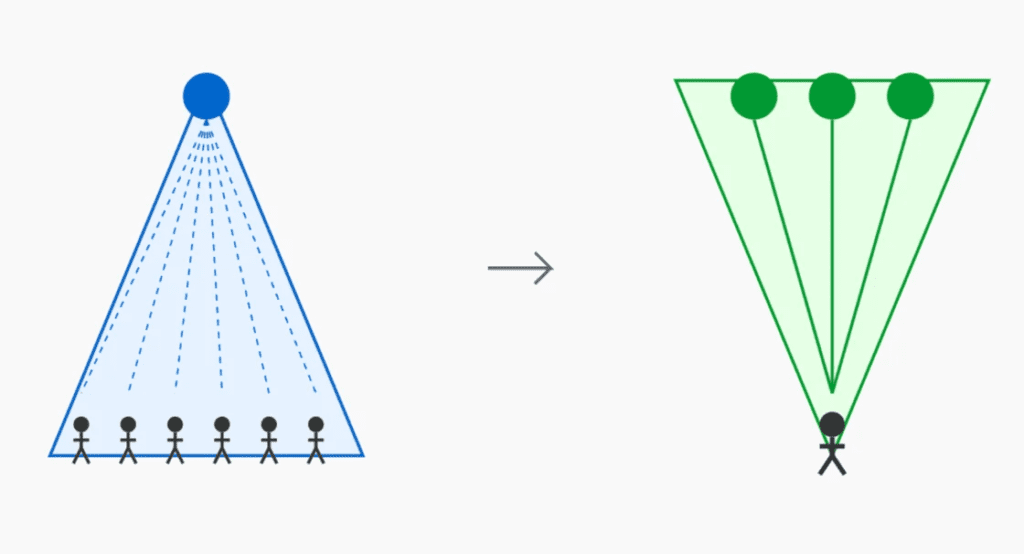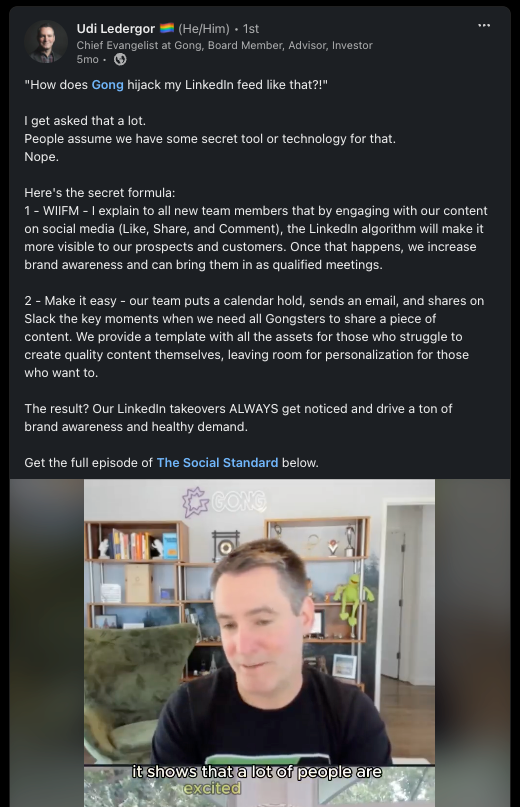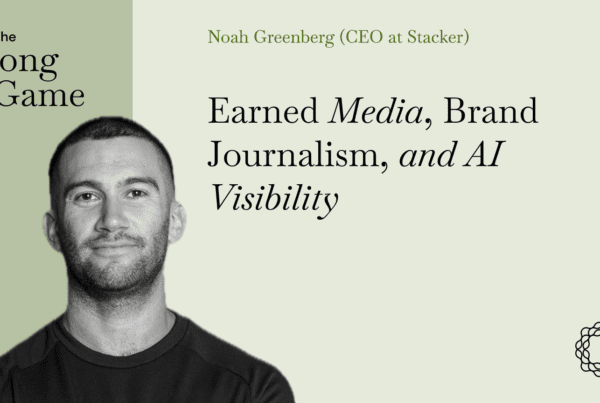
A peculiar thing happens when a brand appears everywhere at once. It stops being a brand and starts being the brand.
You’ve experienced this before.
You Google something, and one name keeps coming up, not just in one search result, but in every result. You open LinkedIn and see a product Loom clip shared by three different people, seemingly uncoordinated but suspiciously well-timed. You hear a podcast, and the same person who authored the blog you read last week is now being interviewed.
By the time you make a purchase decision, it’s barely even a choice. The brand is already etched into your consciousness.
This is the power of omnipresence in marketing.
Not just reach, but repeated exposure. Not just being in the conversation, but appearing so frequently that you become the consensus. It’s a strategy that works particularly well in organic marketing – SEO, social, and AI-driven discovery – but more fundamentally, it’s a psychological principle rooted in how humans perceive credibility.
I think, in some ways, this is common sense. It’s what those who talk about ABM are really going for, a straying from mass marketing into targeted, in-depth, and highly resonant marketing.

And while it can be engineered, it can never feel engineered. The most effective omnipresence strategies feel like serendipity, like the world itself is nudging you toward a decision.
The Flashlight Effect
Before I go further, when I say “omnipresence,” I don’t actually mean appearing everywhere.
I mean appearing like you appear everywhere.
As in, unless you have an unlimited budget, it’s actually counterproductive to try to be on every channel and at every touchpoint.
Rather, you want to identify the most propitious surface areas where you have a comparative advantage, and where your target segment is spending time and attention, and saturate that surface area.
Think of it like a flashlight effect, where without the illumination of the sun, you merely have to focus your attention on a finite surface area of focus. You, as a brand, find that well-lit area and appear in it, favorably, as much as possible.

Now, I’ll play out several scenarios and stories where ubiquity wins, where omnipresence carries cumulative and compounding advantages, from search to social to memes to books.
Surround Sound SEO: How to Hack Consensus
If you were searching for the best B2B SEO agency, how would you decide?
You might start with a Google search, reading the first few results: “Top SEO Agencies of 2025.” Maybe you click on one or two. You notice the same agency name popping up on multiple lists. Maybe you check a review site: same name again. Later, while scrolling LinkedIn, you see someone you respect mentioning them. By the time you visit their website, you come in with strong affinity and awareness for this particular brand.
This is Surround Sound SEO, a strategy that goes beyond ranking for a keyword and focuses on owning the entire search landscape for product discovery queries. Instead of relying solely on your own domain to rank, you ensure your brand appears across every page that does rank. Listicles, guest articles, review sites, forums. Everywhere a prospect might look, your brand is already present.
The concept was pioneered at HubSpot in 2019, where I worked alongside Scott Tousley and Irina Nica to develop a scalable version of the approach.
The insight was simple: conversion rates weren’t just about how much traffic we got, but how often someone saw our name before they made a decision, particularly in product discovery search phrases.
Nick Eubanks, around the same time, wrote about the “SERP Monopoly” strategy, the same idea, framed mathematically: if you control multiple spots on a search results page, you stack cumulative click-through-rates, and thus traffic and conversions.
Tim Ferriss used the same principle to launch The 4-Hour Workweek, coordinating a blitz across every major media channel, specifically focusing on nascent bloggers (untapped at the time) and centering it around SWSX, his audience consumed.
But this isn’t just an SEO tactic. It’s a fundamental principle of persuasion.
Repeated exposure builds credibility. Familiarity breeds trust. The more frequently someone sees your name, the more legitimate you seem.
And in an AI-driven future, where search engines generate answers by compiling sources and predicting patterns, the Surround Sound effect may become even more pronounced. If large language models pull from multiple citations and a corpus of information related to semantic patterns, the more frequently your brand appears, the more likely you are to be part of the answer.
Social Media Ubiquity: The Clay & Gong Playbook
On social media, omnipresence benefits from compounding network effects.
Take Clay, a fast-growing SaaS product. Clay had a natural wow moment in their product, in that once users built cool tables and workflows, they wanted to share their work. They were proud of the complex workflows they built in Clay, and because many of them were consultants or agency owners, sharing their setups made them look competent and innovative (to potential clients).
So Clay didn’t need to brute-force its presence on social. It just poured gasoline on an organic fire.
Bruno Estrella, Clay’s head of marketing, designed a creator incentive program to amplify this effect (paraphrased from this excellent MKT1 interview):
- Make users look smart: every new feature launch included plug-and-play assets that influencers could share.
- Programmatic content scaling: Clay auto-generated social videos with AI avatars and voiceovers to feature users in new product demos.
- Revenue-sharing: Users who shared content got financial incentives when their referrals converted.
Social feeds flooded with Clay, but in a way that felt organic, not engineered.
Gong took a different but equally effective route: instead of relying on users, they turned their own employees into influencers.
Every new hire was encouraged to post about their first week. Product launches were timed with internal LinkedIn takeovers. Instead of a corporate account posting about an event, 30+ employees would post about it at the same time.
LinkedIn’s algorithm naturally favors personal pages over company pages. Gong hacked this dynamic to dominate LinkedIn.
In both cases, the brands didn’t spread themselves thin across every possible channel. They saturated a single, high-impact channel, so if you followed even a handful of people in their ecosystem, you couldn’t escape them.

Manufactured Consent (but with Memes and Movies)
Omnipresence isn’t just for B2B. Hollywood has perfected this playbook (quite surreptitiously might I add).
Think about the last time a new TV show or movie seemed to completely take over your feed. Memes coming out of nowhere featuring the same TV characters – which provokes a bit of curiosity, no? Is there something I’m missing out on? Why does everyone seem to be in on the joke while I don’t understand it?
It rarely happens by accident (not if you’ve read Trust Me I’m Lying or similar books anyway). I can’t prove it, but I strongly believe studios engineer viral moments by seeding memes and cultural references across multiple influential accounts at the same time.
Recent examples I’ve seen include Severance, which coupled Instagram memes with very creative real-world pop-ups in NYC, and White Lotus. And then there was Barbenheimer, the viral phenomenon that made Barbie and Oppenheimer inseparable in the cultural lexicon. I highly suspect their was some backroom meme dealing happening to coincide with traditional marketing and ad spend.
The great thing is this stuff feels incredibly natural (unless you’re a salty and cynical marketer like me). Thus, once the snowball starts rolling, real and unprompted word-of-mouth, meme sharing, and conversation happens (how many times has someone told me to watch Severance or White Lotus the last few months?!)
Threshold Effects and the Swarm Strategy
The mind is an efficient gatekeeper, designed to filter out the overwhelming flood of information we’re exposed to daily. But at some point, that brand crosses an invisible threshold, and suddenly, it’s everywhere.
It’s not that the company suddenly started marketing more aggressively. More often than not, the change happens in your perception. A few exposures might have slipped past unnoticed, but at some point, whether it’s the fourth time or the tenth, something flips. The brand is now “on your radar.” You might not even remember where you first encountered it, but now it seems like a dominant player.
This is the Threshold Effect: the idea that below a certain level of exposure, nothing happens, but once you hit a critical mass, your results accelerate exponentially.
It’s the same way that a few snowflakes on a mountainside don’t matter, but past a certain accumulation, an avalanche is inevitable.
And it’s also why many marketing programs fail, not because the message was weak or the product bad, but because they never reached the threshold necessary to make an impact (or at least measure one).
Now, how do you hit that threshold as quickly as possible? Enter the Swarm Strategy.
Swarming: The Strategy of Overwhelming Presence
I know it’s uncouth, or at the very least, trite and overused to pull warfare analogies into the business world. But this one works well, so follow me.
Swarming, in its original military context, is an asymmetric warfare strategy. It’s used by smaller forces against larger, more established enemies. Instead of a direct frontal assault, a swarming force attacks from multiple directions at once, overwhelming defenses and forcing a reaction.
In other words, instead of dipping your toes, it may be more propitious to pour real, focused effort into something, obviously with parameters for success and failure (a stop loss function, so to speak). But dipping your toes into the water may not actually prove to be a useful marketing experiment.
Ryan Holiday applies this concept to learning, which I love.
When he wants to deeply understand a topic, he doesn’t just read one book about it. He surrounds himself with information from every possible angle: biographies, academic papers, conversations with experts, documentaries. Instead of a linear learning process, he immerses himself, hitting the topic from multiple directions until understanding is inevitable.
The same applies to marketing. Instead of placing a few scattered touchpoints and hoping people notice, you want to flood the zone.
The Future: Omnipresence in AI-Driven Discovery
As search evolves from ten blue links to AI-generated answers, the need for omnipresence will only grow.
LLMs don’t “rank” sites the way Google does, though classic search success seems to correlate extremely with success in LLMs (with the obvious causal connection of search functions e.g. ChatGPT search and Perplexity). It’s a pattern recognition machine, and well, you’ve got to have some data points (visibility) to form a pattern (omnipresence, ubiquity).
If the future of search is citation-driven, Surround Sound SEO may be a strong cumulative advantage.
Want more insights like this? Subscribe to our Field Notes.


